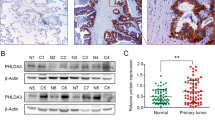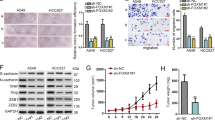Abstract
The WW domain-containing oxidoreductase (WWOX) is a tumor suppressor that is lost or decreased in most human tumors. The role of WWOX in human lung carcinoma invasion is still not clear. This study aimed to elucidate the potential role of WWOX in lung cancer cell invasion. WWOX mRNA levels in human lung cancers and lung cancer cell lines were assayed by quantitative real-time PCR. WWOX in lung cancer cell lines was manipulated by transfection of expression vector or small interfering RNA. Cell migration and invasion were assessed by wound healing and/or transwell migration and invasion assays. The protein levels of WWOX, E-cadherin and RUNX2 were analyzed by western blot or immunofluorescence. WWOX expression is inversely correlated to invasiveness of lung cancer. WWOX overexpression in highly invasive H1299 cells reduced cell motility and invasiveness, and inhibited the expression of RUNX2 and its target gene matrix metalloproteinase-9 (MMP-9). Silencing WWOX in less invasive NL9980 cells resulted in opposite effects. Overexpressing RUNX2 in H1299 or silencing RUNX2 in NL9980 cells reversed the effects of WWOX. These results suggested that WWOX inhibited the invasive phenotype of lung cancer through downregulating the expression of RUNX2.
This is a preview of subscription content, access via your institution
Access options
Subscribe to this journal
Receive 12 print issues and online access
$259.00 per year
only $21.58 per issue
Buy this article
- Purchase on Springer Link
- Instant access to full article PDF
Prices may be subject to local taxes which are calculated during checkout





Similar content being viewed by others
References
Torre LA, Bray F, Siegel RL, Ferlay J, Lortet-Tieulent J, Jemal A . Global cancer statistics, 2012. CA Cancer J Clin 2015; 65: 87–108.
Freeman-Keller M, Goldman J, Gray J . Vaccine immunotherapy in lung cancer: clinical experience and future directions. Pharmacol Ther 2015; 153: 1–9.
Travis WD, Brambilla E, Nicholson AG, Yatabe Y, Austin JH, Beasley MB et al. The 2015 World Health Organization Classification of Lung Tumors: impact of genetic, clinical and radiologic advances since the 2004 classification. J Thorac Oncol 2015; 10: 1243–1260.
Bednarek AK, Laflin KJ, Daniel RL, Liao Q, Hawkins KA, Aldaz CM . WWOX, a novel WW domain-containing protein mapping to human chromosome 16q23.3-24.1, a region frequently affected in breast cancer. Cancer Res 2000; 60: 2140–2145.
Chang NS, Pratt N, Heath J, Schultz L, Sleve D, Carey GB et al. Hyaluronidase induction of a WW domain-containing oxidoreductase that enhances tumor necrosis factor cytotoxicity. J Biol Chem 2001; 276: 3361–3370.
Gardenswartz A, Aqeilan RI . WW domain-containing oxidoreductase’s role in myriad cancers: clinical significance and future implications. Exp Biol Med (Maywood) 2014; 239: 253–263.
Baykara O, Demirkaya A, Kaynak K, Tanju S, Toker A, Buyru N . WWOX gene may contribute to progression of non-small-cell lung cancer (NSCLC). Tumour Biol 2010; 31: 315–320.
Donati V, Fontanini G, Dell’Omodarme M, Prati MC, Nuti S, Lucchi M et al. WWOX expression in different histologic types and subtypes of non-small cell lung cancer. Clin Cancer Res 2007; 13: 884–891.
Yang L, Liu B, Huang B, Deng J, Li H, Yu B et al. A functional copy number variation in the WWOX gene is associated with lung cancer risk in Chinese. Hum Mol Genet 2013; 22: 1886–1894.
Fabbri M, Iliopoulos D, Trapasso F, Aqeilan RI, Cimmino A, Zanesi N et al. WWOX gene restoration prevents lung cancer growth in vitro and in vivo. Proc Natl Acad Sci USA 2005; 102: 15611–15616.
Zhou Y, Shou F, Zhang H, You Q . Adenovirus-delivered wwox inhibited lung cancer growth in vivo in a mouse model. Cancer Gene Ther 2016; 23: 1–6.
Matteucci E, Maroni P, Luzzati A, Perrucchini G, Bendinelli P, Desiderio MA . Bone metastatic process of breast cancer involves methylation state affecting E-cadherin expression through TAZ and WWOX nuclear effectors. Eur J Cancer 2013; 49: 231–244.
Liu CJ, Shen WG, Peng SY, Cheng HW, Kao SY, Lin SC et al. miR-134 induces oncogenicity and metastasis in head and neck carcinoma through targeting WWOX gene. Int J Cancer 2014; 134: 811–821.
Del Mare S, Aqeilan RI . Tumor suppressor WWOX inhibits osteosarcoma metastasis by modulating RUNX2 function. Sci Rep 2015; 5: 12959.
Kurek KC, Del Mare S, Salah Z, Abdeen S, Sadiq H, Lee SH et al. Frequent attenuation of the WWOX tumor suppressor in osteosarcoma is associated with increased tumorigenicity and aberrant RUNX2 expression. Cancer Res 2010; 70: 5577–5586.
Kumar G, Patlolla JM, Madka V, Mohammed A, Li Q, Zhang Y et al. Simultaneous targeting of 5-LOX-COX and ODC block NNK-induced lung adenoma progression to adenocarcinoma in A/J mice. Am J Cancer Res 2016; 6: 894–909.
Kumar G, Dange P, Kailaje V, Vaidya MM, Ramchandani AG, Maru GB . Polymeric black tea polyphenols modulate the localization and activity of 12-O-tetradecanoylphorbol-13-acetate-mediated kinases in mouse skin: mechanisms of their anti-tumor-promoting action. Free Radic Biol Med 2012; 53: 1358–1370.
Pyter LM, Husain Y, Calero H, McKim DB, Lin HY, Godbout JP et al. Tumors alter inflammation and impair dermal wound healing in female mice. PLoS One 2016; 11: e0161537.
Ma C, Zeng C, Jin L, Yang Y, Li P, Chen L et al. GSK3β mediates the carcinogenic effect of HPV16 in cervical cancer. Sci Rep 2015; 5: 16555.
Chen Y, Tan X, Ding Y, Mai B, Huang X, Hu G et al. WWOX CNV-67048 functions as a risk factor for epithelial ovarian cancer in Chinese women by negatively interacting with oral contraceptive use. Biomed Res Int 2016; 2016: 6594039.
Schirmer MA, Lüske CM, Roppel S, Schaudinn A, Zimmer C, Pflüger R et al. Relevance of Sp binding site polymorphism in WWOX for treatment outcome in pancreatic cancer. J Natl Cancer Inst 2016; 108: djv387.
Ekizoglu S, Bulut P, Karaman E, Kilic E, Buyru N . Epigenetic and genetic alterations affect the WWOX gene in head and neck squamous cell carcinoma. PLoS One 2015; 10: e0115353.
Li J, Liu J, Ren Y, Liu P . Roles of the WWOX in pathogenesis and endocrine therapy of breast cancer. Exp Biol Med (Maywood) 2015; 240: 324–328.
Becker S, Markova B, Wiewrodt R, Hoffarth S, Hähnel PS, Pleiner S et al. Functional and clinical characterization of the putative tumor suppressor WWOX in non-small cell lung cancer. J Thorac Oncol 2011; 6: 1976–1983.
Ferguson BW, Gao X, Zelazowski MJ, Lee J, Jeter CR, Abba MC et al. The cancer gene WWOX behaves as an inhibitor of SMAD3 transcriptional activity via direct binding. BMC Cancer 2013; 13: 593.
Abu-Odeh M, Hereema NA, Aqeilan RI . WWOX modulates the ATR-mediated DNA damage checkpoint response. Oncotarget 2016; 7: 4344–4355.
Płuciennik E, Nowakowska M, Pospiech K, Stępień A, Wołkowicz M, Gałdyszyńska M et al. The role of WWOX tumor suppressor gene in the regulation of EMT process via regulation of CDH1-ZEB1-VIM expression in endometrial cancer. Int J Oncol 2015; 46: 2639–2648.
El-Gendi SM, Mostafa MF . Runx2 expression as a potential prognostic marker in invasive ductal breast carcinoma. Pathol Oncol Res 2016; 22: 461–470.
Guo ZJ, Yang L, Qian F, Wang YX, Yu X, Ji CD et al. Transcription factor RUNX2 up-regulates chemokine receptor CXCR4 to promote invasive and metastatic potentials of human gastric cancer. Oncotarget 2016; 7: 20999–21012.
Li XQ, Lu JT, Tan CC, Wang QS, Feng YM . RUNX2 promotes breast cancer bone metastasis by increasing integrin α5-mediated colonization. Cancer Lett 2016; 380: 78–86.
Acknowledgements
This study was supported by the Annual ‘Six Talent Summit’ Grants of Jiangsu province (2014-WSW-064) and Grant from Wuxi Hospital Management Center (YGZXL1304).
Author information
Authors and Affiliations
Corresponding authors
Ethics declarations
Competing interests
The authors declare no conflict of interest.
Rights and permissions
About this article
Cite this article
Zheng, QW., Zhou, YL., You, QJ. et al. WWOX inhibits the invasion of lung cancer cells by downregulating RUNX2. Cancer Gene Ther 23, 433–438 (2016). https://doi.org/10.1038/cgt.2016.59
Received:
Revised:
Accepted:
Published:
Issue Date:
DOI: https://doi.org/10.1038/cgt.2016.59
This article is cited by
-
A p53/TIAF1/WWOX triad exerts cancer suppression but may cause brain protein aggregation due to p53/WWOX functional antagonism
Cell Communication and Signaling (2019)
-
Strategies by which WWOX-deficient metastatic cancer cells utilize to survive via dodging, compromising, and causing damage to WWOX-positive normal microenvironment
Cell Death Discovery (2019)
-
VOPP1 promotes breast tumorigenesis by interacting with the tumor suppressor WWOX
BMC Biology (2018)



